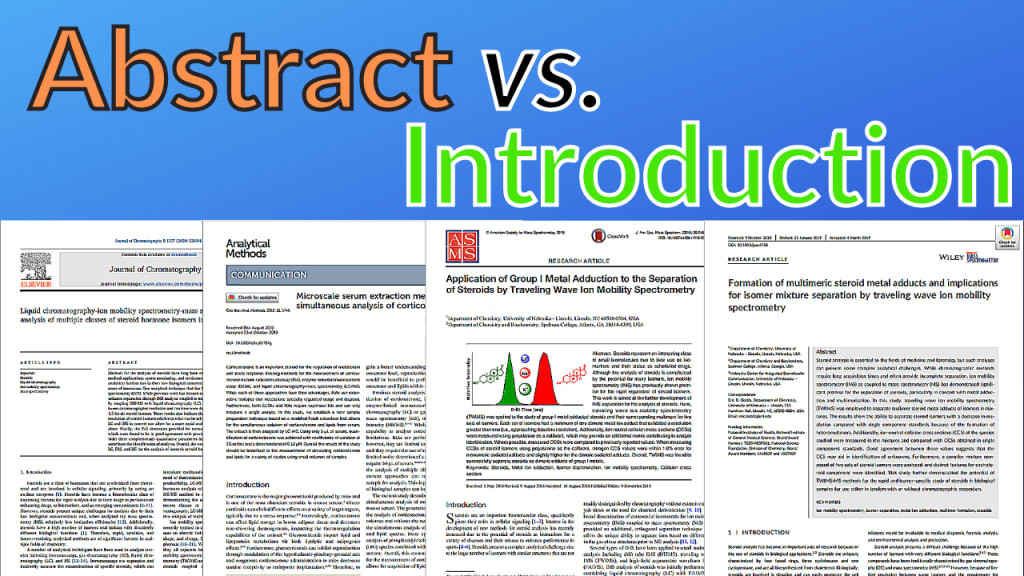Abstract vs. Introduction
3 key differences for writing a research paper

Two essential components of any research paper are the abstract and introduction. However, when you are writing these pieces, it can be difficult to decipher how these sections differ.
Much of the same information should be included in both sections. However, the purpose, structure, and length of your abstract and introduction should be very different. In this post, we will dive into each of these differences to help you to write killer abstracts and introductions!
Purpose
Abstracts and Introductions have fundamentally different purposes.
Abstract
The purpose of your abstract is to give a new reader a synopsis of the study that you performed. Think of it as a sales page. If your article was behind a paywall and someone was debating paying for it, what would they need to know to determine if your paper is worth it? (Unfortunately, this is a real possibility in science today.)
Even if your reader has free access, your abstract should illustrate whether your paper fits their needs and is worth their time to read it. Ultimately, you want to make it clear to a reader what your paper is about, why it is important, and what you found in your study.
Introduction
Your introduction is very different because now the reader has access to or has decided to read your paper. Therefore, the introduction is there to prepare your reader to understand what you did in your study.
In your introduction, you want to cover why your study is important, what you are studying, the previous related studies, and a brief summary of what you did in your study.
Structure
Because of the different purposes, abstracts and introductions should have different structures. If you want to go further in-depth into my research paper writing process, consider getting my research paper checklist.
Abstract
While some journals ask you to have different section headings for your abstract, most require you to have one block of text or paragraph. However, within that paragraph, you can follow a specific structure to quickly guide your reader through the study. A great abstract will answer the following questions quickly and concisely.
- Why is your field and/or study important?
- What are the basics of what you are studying?
- What question(s) are you answering in your study?
- How did you answer the question(s)?
- What was the answer to these question(s)?
By answering these questions, you will allow your potential reader to know exactly what they will learn by reading your paper.
Introduction
While some of the content will overlap between the abstract and introduction, a great introduction will have a different structure suited to prepare the reader to understand the study.
Therefore, a great introduction will answer the following questions in order:
- Why is your field important?
- What is the background information a person would need in order to understand your study?
- What is the previous research that impacts the understanding of this study?
- Why is this study novel?
- What are you doing in this study?
By answering these questions, you will develop an introduction that allows your reader to care about your study, understand your study, and know the context and novelty of your study.
Length
The most striking difference between an abstract and an introduction is their length. While an abstract may look like it is covering more information, an abstract should be much shorter than your introduction.
Abstract
Most journals have specific word or character limits for an abstract. Common word limits can be from 200-600 words. I find that the most common word limit is around 350 words for an abstract. This means that you must cover a lot of information in a very short space.
As a result, your abstract should be very concise. All of the nuances that you will explore in your paper are not necessary to include in the abstract itself. Instead, you should inform of the most important parts of your paper. Everything in your abstract has the sole purpose of getting your reader to want to read your article.
Introduction
On the other hand, the length of your introduction is much longer. For a normal research article, a good introduction should be about 1.5-2 pages double-spaced. For many beginner academic writers, this may seem like a short introduction. However, you need to remember the purpose of your introduction.
Many writers will treat their introduction as a place to lay out everything they know about the topic. They think that this presents them as an expert in the field and will increase their ability to publish their article. Unfortunately, they are wrong.
The fact is that the editors are not focused on you. They are focused on the reader.
If a reader wanted to know everything on a specific topic, they would read a review article or a textbook. In your paper’s introduction, your reader simply wants to know what they need to know to understand your study.
For example, if your paper is about the use of a specific method to study something, you may inform your audience of the other potential methods and their disadvantages in your introduction. However, you shouldn’t dive into how each of these methods works. If the reader is interested in the difference between these methods, they can pursue review articles or search each method.
Deciphering between what does and does not belong in your introduction is imperative to the readability of your article. The people who are likely most interested in your article are those that know the basic information in the field at large. They do not want to read 5 pages of you recounting the history of their field; however, they do want to read about nuanced information that is important to your paper, but not common knowledge to the field at large.
Takeaways
When you are writing a research paper, it is important to include polished abstracts and introductions to enhance your ability to be published and the reception of your article. However, you need to have two different strategies when writing an abstract compared to your introduction. Remember these three important differences to create a polished abstract and introduction:
- The purpose of your abstract is to encourage a reader to read your paper, whereas the purpose of your introduction is to prepare the reader to understand your study.
- The structure of your abstract should include information from all sections of your paper vs. the structure of your introduction is to answer the why, what, and how of your research field and study.
- Your abstract should be very short (around 350 words) compared to your introduction which should be longer (1.5-2 pages), but in both, it is important to remember to include only necessary information and be concise.






Comments
There are no comments for this story
Be the first to respond and start the conversation.